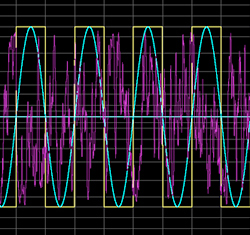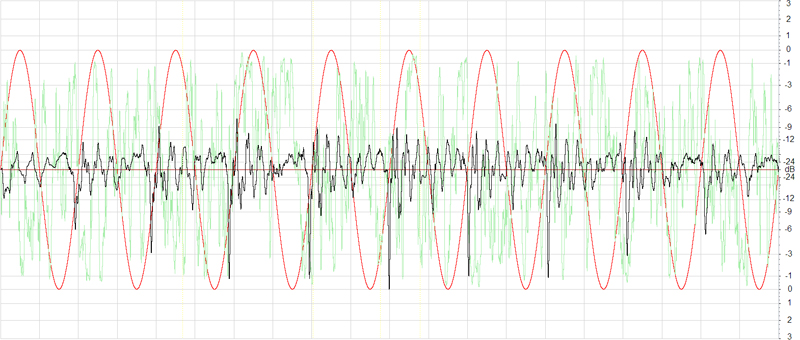
Alternatively, one may carry out a toaster test using a test signal having a spectral content more closely resembling the intended program material for the application at hand.
For our application the program material to be reproduced by our loudspeaker system will be live speech or music with little or no compression (amplitude compression, not data compression). This should give us a relatively broadband signal very similar to the IEC 60268 specified noise signal.
However, our signal will have a crest factor of approximately 15 dB. A time domain comparison of this type of signal to the IEC268 noise and a sine wave is shown in Figure 2.
Here again the peak level of all three signals is 0 dB. It should be easy to see that the RMS level of this new speech signal is much less than the noise.
The loudspeaker we have selected to use has a reasonably flat frequency response from 50 Hz-12 kHz and a sensitivity of 98 dB referenced to 2.83 Vrms at 1 m.
At a distance of 10 m, this loudspeaker will reproduce the IEC268 noise at 78 dB SPL when driven with an input of 2.83 Vrms. We measure this at 10 m to assure that we are in the far-field for this loudspeaker. It will also reproduce our speech signal at 78 dB SPL at 10 m when driven with an input of 2.83 Vrms.

The reason the measured SPL is the same for both signals is that the RMS input voltage is the same. SPL measured with a slow integration time, as we are referencing here, will correspond well with the RMS value of the input voltage. This is why an RMS meter on a mixing console may be used as a fairly good indicator of SPL once it has been referenced to a particular SPL.
Of course, at high input voltage levels, the output of the loudspeaker may not remain completely linear and some power compression may occur. When each of these signals is at the same RMS level, as described above with the input to the loudspeaker, their peak levels will be different.
This is shown in Figure 3. Here the RMS level of each signal is the same.

Now we can see that to cleanly pass the speech signal without clipping we will need a much larger amplifier than required to pass the IEC268 noise cleanly; but exactly how large?
The sound system design requirements dictate that our loudspeaker needs to produce approximately 88 dB SPL at 20 m with our speech program material. At half this distance, 10 m, this equates to 94 dB. We know the loudspeaker will produce 78 dB at 10 m when driven with 2.83 Vrms.
We need an additional 16 dB, or 17.9 Vrms, to reach 94 dB SPL at 10 m. This loudspeaker has a rated maximum input of 32 Vrms as determined by the toaster test. This gives us 21 dB of gain relative to 2.83 Vrms without the thermal limitations of the loudspeaker causing its response to change by more than 3 dB.
This tells us our loudspeaker can produce the SPL required. In fact, it can be driven 5 dB harder. This is a good thing as thus far we have not accounted for any power compression that may occur.
